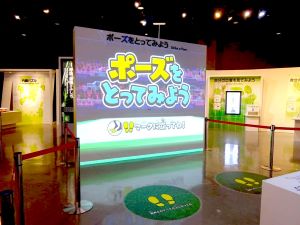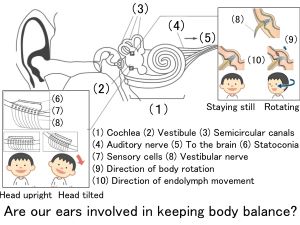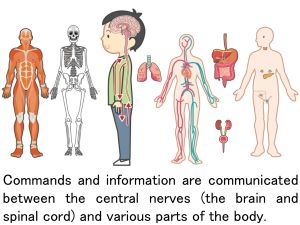Nagoya City Science Museum
TOP > Exhibition Guide > Keyword Search > Starting with "N" > nervous > Strike a Pose
Strike a Pose



Purpose of Exhibition
When you stand on a footprint symbol on the floor and select a game level from among Level 1 (Beginner), Level 2 (Intermediate), and Level 3 (Advanced), a sample pose will be displayed on the large screen.
Imitate the sample pose according to the advice shown on the screen. Three different sample poses will be displayed in sequence. Lastly, the game ends in a Japanese style when you imitate the fourth pose to make a polite bow toward the screen.
After the game, you will be evaluated based on whether you have successfully imitated the three sample poses. (Excellent (3 stars★ 3 ): Gold medal, Good Job (2 stars★ 2 ): Silver medal, Nice Try (1 star★ 1 ): bronze medal)
As the level goes up from 1 to 3, you need more muscle strength and a better sense of balance. Can you take the same pose as all three sample poses given at each level?
Think about the human body and the organs and tissues involved in keeping body balance while enjoying the experience of using your own body.
At the back of this exhibit, more information is provided with illustrations on the organs and tissues involved in keeping body balance.
There are some points to note to fully enjoy this game. Up to two people can participate at one time. Also, only one person should stand on one footprint symbol. The game may not operate properly if there is someone between the players and the screen or near the players. So, the waiting people are requested to stand stay outside the tape barriers located at the left and right sides or step back fromstand behind the footprint symbols.
Meanwhile, the sensor camera may not be able to read your posture accurately depending on the shape and color of your clothes. In such a case, you may not be able to fully enjoy the game.
Additional Knowledge
[ Are our ears involved in keeping body balance? ]
The vestibule in the inner ear of an ear detects the inclination of the body, while the three semicircular canals detect movement forward and backward, to the left and right, and up and down. Moreover, other parts of the body also detect the state of the body. The information thus collected is sent to the central nervous system (the brain and spinal cord).
The central nervous system issues commands to each part of the body according to the body condition, and each part operates in response to respective commands to keep body balance.
[ Are our muscles and bones not being used when we are standings itting still ? ]
Even when we are not moving our body, commands and information are communicated between the central nervous system and muscles and bones to maintain our posture. To this end, other parts of the body also need to work effectively. If any part of our body doesn’t work well, it can affect our movements and lead to different sensations. All parts of our body work together, just like a team competing in team sports.
[ Various parts of the human body perform their functions effectively even in simple poses. ]
For the three levels, the higher the number, the harder it is to take a sample pose.
・ Level 1: Pose with arms outstretched facing forward
・ Level 2: Pose facing sideways while using the muscles of your arms and lower body
・ Level 3: Poses that require a sense of balance and lower-body muscle strength, such as standing on one leg and opening the legs back and forth.
Particularly, for Level 3, we selected sample poses, referring to the poses used to evaluate balance ability and to strengthen the muscles of the legs and hips. So, some people may find it a little difficult to stand still in the same posture as the sample pose.
The sample poses of this exhibit are simple, not requiring a fast body movement, and allow easy judging of the performance of players. However, you can still feel by imitating those poses that various parts of your body work together, making a fine adjustment.
What about athletes performing more difficult movements at competitions, such as the Olympics? You have probably seen photos depicting the moment when athletes are fully focusing and exerting their utmost strength. Well-trained athletes can present themselves beautifully in even the simplest pose, paying minute attention to every part of their body, even the tip of their fingers. They train themselves to improve their ability to control and effectively use various parts of their body.
Article by Tomoko Horiuchi, curator
This item is preparing.
